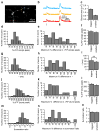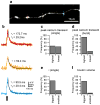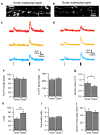Calcium influx measured at single presynaptic boutons of cerebellar granule cell ascending axons and parallel fibers
- PMID: 20049574
- PMCID: PMC3411191
- DOI: 10.1007/s12311-009-0151-3
Calcium influx measured at single presynaptic boutons of cerebellar granule cell ascending axons and parallel fibers
Abstract
Action potential-evoked calcium influx into presynaptic boutons is a key determinant of synaptic strength and function. Here, we have examined the calcium dynamics at individual presynaptic boutons of the cerebellar granule cells in the molecular layer of cerebellar slices and investigated whether different subpopulations of granule cell boutons exhibit different calcium dynamics. We found that a population of boutons with low basal calcium clearance rates may activate a second clearance mechanism and exhibit biphasic calcium decay on high calcium influx induced by bursts of action potentials. We also found that boutons on ascending axons and parallel fibers show similar calcium influx amplitudes and calcium clearance rates in response to action potentials. Lastly, we found that parallel fiber boutons located in the inner molecular layer have a higher calcium clearance rate than boutons located in the outer molecular layer. These results suggest that cerebellar granule cell boutons should not be regarded as a homogeneous population, but rather that different subpopulations of boutons may exhibit different properties. The heterogeneity of presynaptic boutons may allow different learned behaviors to be encoded in the same circuit without mutual interference and may be a general mechanism for increasing the computational capacity of the brain.
Figures




Similar articles
-
Neuromodulation at single presynaptic boutons of cerebellar parallel fibers is determined by bouton size and basal action potential-evoked Ca transient amplitude.J Neurosci. 2009 Dec 9;29(49):15586-94. doi: 10.1523/JNEUROSCI.3793-09.2009. J Neurosci. 2009. PMID: 20007482 Free PMC article.
-
Reliability and heterogeneity of calcium signaling at single presynaptic boutons of cerebellar granule cells.J Neurosci. 2007 Jul 25;27(30):7888-98. doi: 10.1523/JNEUROSCI.1064-07.2007. J Neurosci. 2007. PMID: 17652580 Free PMC article.
-
The H-current secures action potential transmission at high frequencies in rat cerebellar parallel fibers.Eur J Neurosci. 2009 Jan;29(1):87-96. doi: 10.1111/j.1460-9568.2008.06566.x. Epub 2008 Dec 12. Eur J Neurosci. 2009. PMID: 19087162
-
The role of calcium in synaptic plasticity and motor learning in the cerebellar cortex.Neurosci Biobehav Rev. 2012 Apr;36(4):1153-62. doi: 10.1016/j.neubiorev.2012.01.005. Epub 2012 Jan 28. Neurosci Biobehav Rev. 2012. PMID: 22305995 Review.
-
Models of calcium dynamics in cerebellar granule cells.Cerebellum. 2012 Mar;11(1):85-101. doi: 10.1007/s12311-010-0216-3. Cerebellum. 2012. PMID: 20922512 Review.
Cited by
-
Fiber-based in vivo imaging: unveiling avenues for exploring mechanisms of synaptic plasticity and neuronal adaptations underlying behavior.Neurophotonics. 2024 Sep;11(Suppl 1):S11507. doi: 10.1117/1.NPh.11.S1.S11507. Epub 2024 Feb 22. Neurophotonics. 2024. PMID: 38390518 Free PMC article.
-
A reinforcing circuit action of extrasynaptic GABAA receptor modulators on cerebellar granule cell inhibition.PLoS One. 2013 Aug 19;8(8):e72976. doi: 10.1371/journal.pone.0072976. eCollection 2013. PLoS One. 2013. PMID: 23977374 Free PMC article.
-
How and Why the Cerebellum Recodes Input Signals: An Alternative to Machine Learning.Neuroscientist. 2022 Jun;28(3):206-221. doi: 10.1177/1073858420986795. Epub 2021 Feb 9. Neuroscientist. 2022. PMID: 33559532 Free PMC article.
-
Computational anatomy: the cerebellar microzone computation.Oxf Open Neurosci. 2025 May 16;4:kvaf001. doi: 10.1093/oons/kvaf001. eCollection 2025. Oxf Open Neurosci. 2025. PMID: 40401259 Free PMC article.
-
Functional contributions of the plasma membrane calcium ATPase and the sodium-calcium exchanger at mouse parallel fibre to Purkinje neuron synapses.Pflugers Arch. 2013 Feb;465(2):319-31. doi: 10.1007/s00424-012-1172-1. Epub 2012 Nov 9. Pflugers Arch. 2013. PMID: 23138229
References
-
- Napper RM, Harvey RJ. Number of parallel fiber synapses on an individual Purkinje cell in the cerebellum of the rat. J Comp Neurol. 1988;274(2):168–177. - PubMed
-
- Palay SL, Chan-Palay V. Cerebellar cortex: cytology and organization. Springer-Verlag, Berlin; 1974.
-
- Braitenberg V, Atwood RP. Morphological observations on the cerebellar cortex. J Comp Neurol. 1958;109(1):1–33. - PubMed
-
- Eccles JC, Ito M, Szentagothai J. The cerebellum as a neuronal machine. Springer; Berlin: 1967.
-
- Eccles JC, Llinas R, Sasaki K. Parallel fibre stimulation and the responses induced thereby in the Purkinje cells of the cerebellum. Exp Brain Res. 1966;1(1):17–39. - PubMed
Publication types
MeSH terms
Grants and funding
LinkOut - more resources
Full Text Sources

